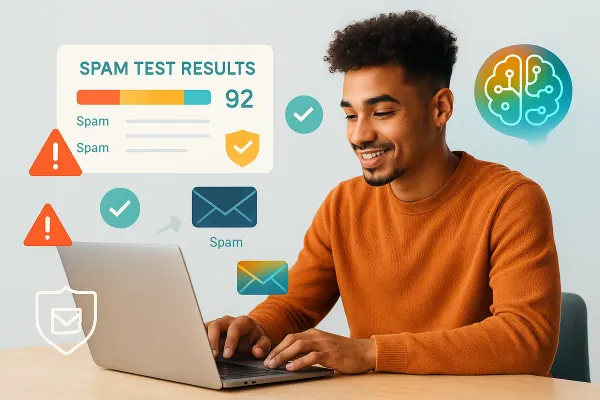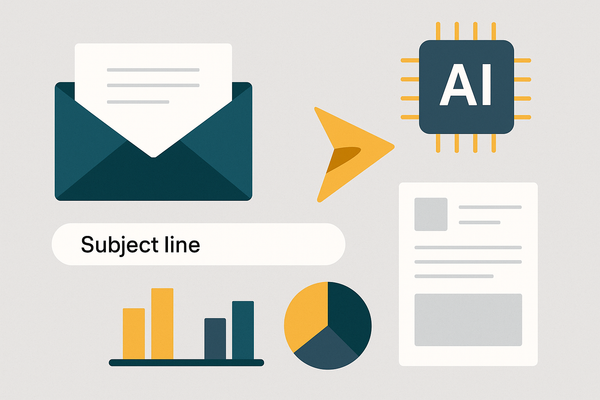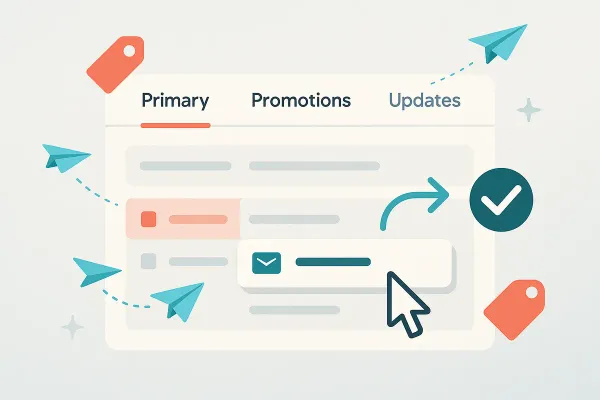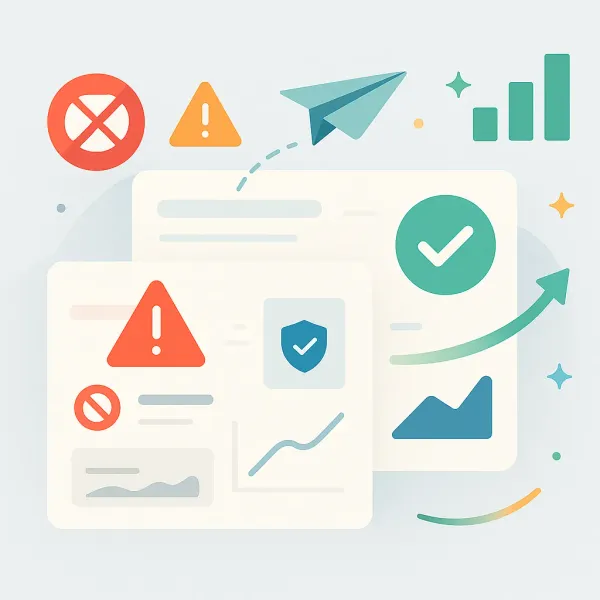AI Analytics & Optimisation Tools for Email Campaigns
AI analytics tools for email: Compare 9 platforms with real reviews. Free options included. Find tools that boost open rates & conversions.
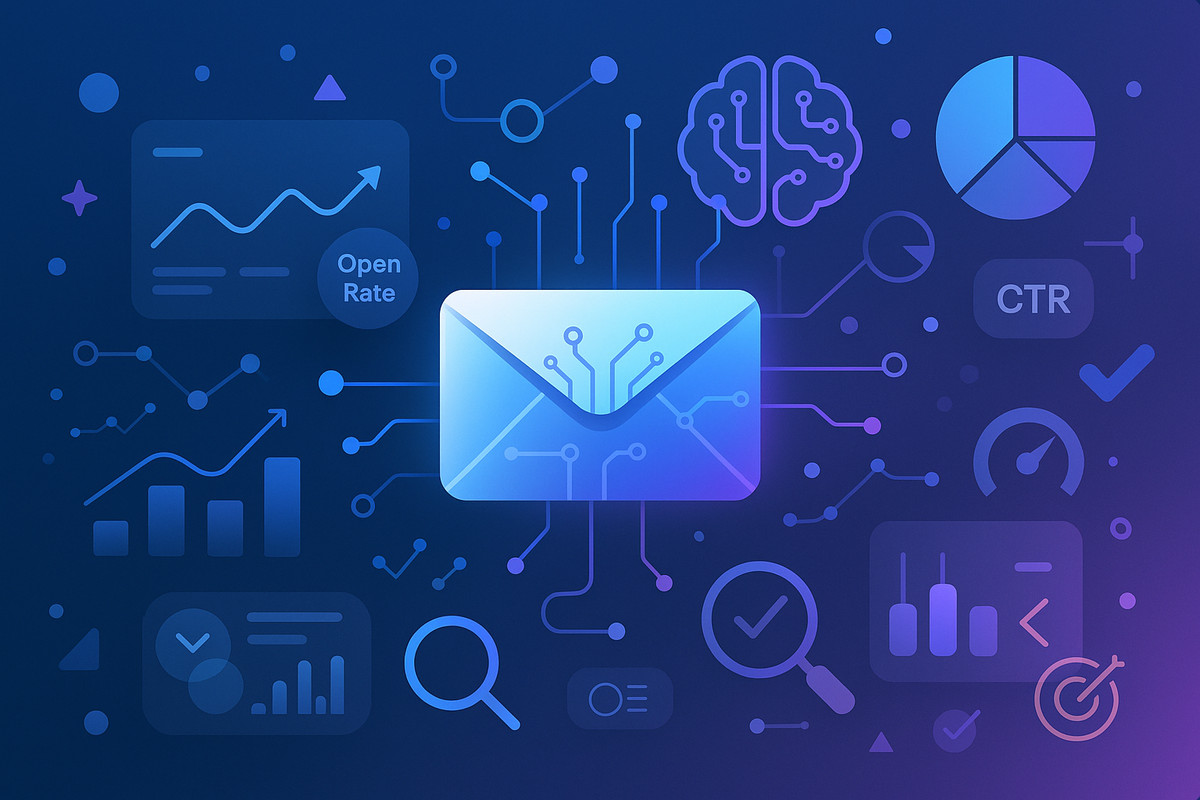
Email marketers face a mounting challenge: drowning in campaign data without clear insights on what drives results. You're tracking opens, clicks, and conversions, but translating these metrics into actionable improvements remains frustratingly elusive. The difficulty in selecting effective AI tools to enhance email campaign performance has become a critical pain point as inboxes grow more competitive and subscriber expectations rise.
AI-powered analytics and optimisation tools promise to bridge this gap, offering predictive insights, automated testing, and intelligent recommendations. But with dozens of platforms claiming revolutionary results, how do you identify which solutions actually deliver measurable improvements for email marketers seeking AI-driven solutions to improve campaign outcomes?
Full transparency: This guide is operated by Groupmail. We provide free AI tools that anyone can use without signup. This article features our tools alongside other specialized platforms to help you find the right solution for your needs.
Research Methodology
Created by: The Groupmail Team
Research Period: 2024-2025
Sources Analyzed: G2, Capterra, Reddit, Trustpilot, industry reports
Featured: 9 AI analytics and optimisation tools
Our Research Methodology: As email marketing practitioners running Groupmail, we've researched AI analytics and optimisation tools for email campaigns extensively—analyzing verified user reviews from G2, Capterra, Reddit, and Trustpilot, along with published case studies and industry benchmarks to identify which solutions actually work for email marketers seeking AI-driven solutions to improve campaign outcomes.
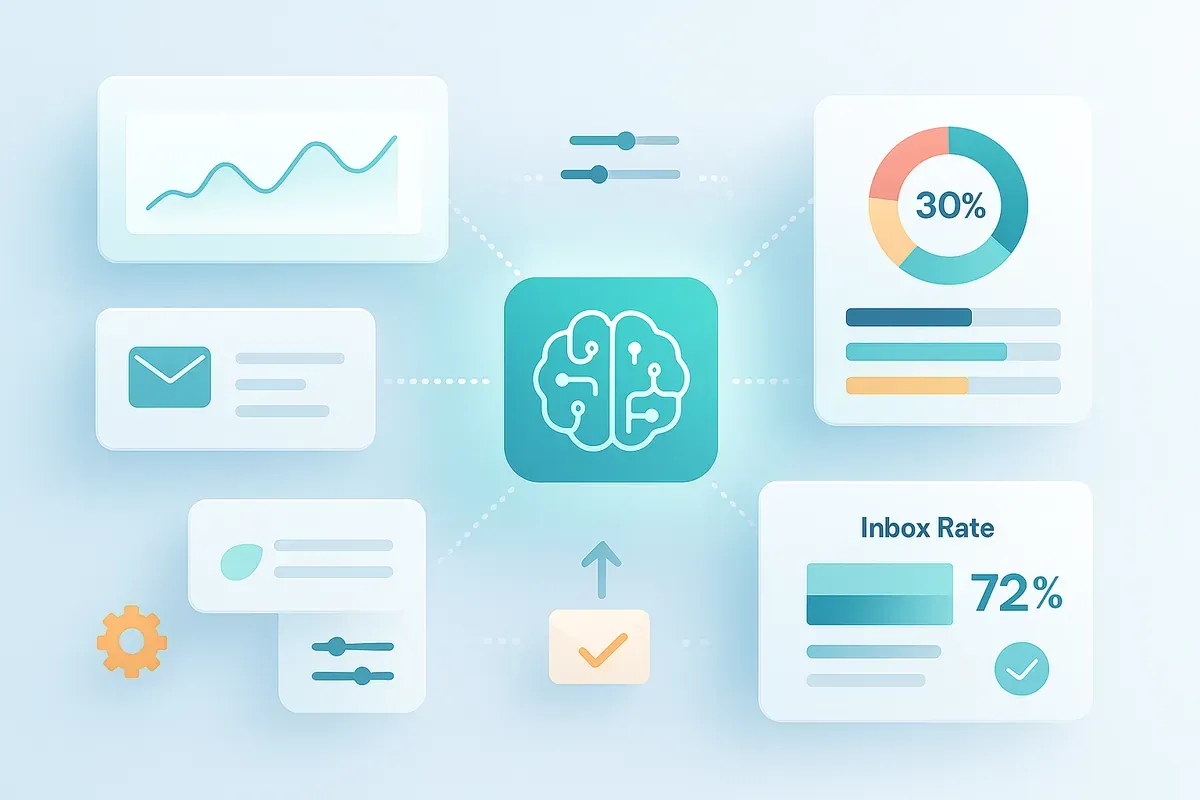
TL;DR - Key Takeaways:
- AI analytics tools reduce analysis time by 60-75% while identifying optimization opportunities human reviewers typically miss
- Best free option: Groupmail's AI Subject Line Tester provides instant predictive scoring without requiring account creation
- Enterprise recommendation: Seventh Sense offers sophisticated send-time optimization using individual subscriber behavior patterns
- Groupmail positioning: Free AI tools (subject line generator, tester, spam checker) complement any email platform you're currently using
- Key insight: Most marketers see 15-30% improvement in engagement metrics within first 90 days of implementing AI-driven optimization
Comparison Table: AI Analytics & Optimisation Tools
| Tool | Best For | Price | Key Strength | Rating |
|---|---|---|---|---|
| Groupmail | Subject line optimization | Free | No-signup AI tools | 4.8/5 |
| Seventh Sense | Send-time optimization | $64/mo | Individual timing analysis | 4.7/5 |
| Phrasee | Enterprise brand voice | $500+/mo | Custom language models | 4.5/5 |
| Optimail | Automated A/B testing | $49/mo | Continuous optimization | 4.4/5 |
| Mailchimp | Small business analytics | $13/mo | Integrated dashboard | 4.3/5 |
| ActiveCampaign | Predictive sending | $49/mo | CRM integration | 4.6/5 |
| Klaviyo | E-commerce analytics | $45/mo | Revenue attribution | 4.6/5 |
| Constant Contact | Ease of use | $12/mo | Beginner-friendly AI | 4.0/5 |
| Moosend | Budget AI features | $9/mo | Affordable automation | 4.1/5 |
Free AI Tools: Start Without Investment
Quick Answer: Free AI email tools provide immediate optimization capabilities without financial commitment, making them ideal for testing AI's impact before platform investment. Groupmail's suite offers subject line generation, testing, and spam checking that work independently of your email service provider.
1. Groupmail AI Subject Line Generator - Instant Ideation
Best for: Overcoming creative blocks and generating diverse subject line variations quickly
Pricing: Free (no account required)
When you're staring at a blank screen wondering how to capture attention in a crowded inbox, Groupmail's AI Subject Line Generator solves the immediate creative paralysis. Enter your campaign topic, select your tone (professional, casual, urgent, friendly), and receive 10 unique subject line suggestions within seconds.
The tool leverages language models trained on high-performing email campaigns across industries. According to Campaign Monitor's email marketing benchmarks, personalized subject lines increase open rates by 26%, and this generator incorporates proven personalization patterns.
How it works:
- Input basic campaign information (product, offer, audience)
- Select tone and style preferences
- Receive 10 AI-generated suggestions instantly
- Copy favorites directly to your email platform
Key features:
- No character limit restrictions
- Emoji suggestions when appropriate
- Industry-specific optimization
- Works with any email service provider
When to use it: Perfect for rapid campaign ideation, A/B test creation, or when your team needs fresh creative direction. Particularly valuable for marketers managing multiple campaigns weekly who need consistent creative quality without extensive brainstorming sessions.
Honest limitations: This is an ideation tool that won't handle campaign scheduling, list segmentation, or performance tracking. It generates suggestions but doesn't learn from your specific audience's behavior. For a complete solution, explore Groupmail's full platform—featuring unlimited sending, drag-and-drop builder, and comprehensive analytics. Or use our free tools alongside specialized solutions you're already using.
Try Groupmail's AI Subject Line Generator →
2. Groupmail AI Subject Line Tester - Predictive Scoring
Best for: Validating subject lines before sending to identify potential performance issues
Pricing: Free (no account required)
After generating subject line ideas, the next challenge becomes selecting which will actually drive opens. The AI Subject Line Tester analyzes your candidates against multiple performance factors, providing a predictive score that helps you choose confidently.
The tool examines length, word choice, personalization elements, power words, spam trigger patterns, and emoji usage. According to research from Litmus, subject lines between 41-50 characters achieve the highest open rates, and this tester flags length concerns automatically.
Analysis criteria:
- Character count optimization (mobile vs. desktop)
- Spam trigger word detection
- Emotional appeal scoring
- Urgency and curiosity elements
- Personalization opportunity identification
Scoring breakdown: The tool provides an overall score (0-100) with specific feedback on:
- Deliverability concerns: Words or patterns that might trigger spam filters
- Length recommendations: Character count for mobile visibility
- Engagement factors: Presence of curiosity gaps, urgency, or benefit statements
- Improvement suggestions: Specific changes to boost predicted performance
Real user feedback: "I was consistently scoring 65-70 on my subject lines. After implementing the tester's suggestions, my average score jumped to 82-85, and my open rates increased 18% within 30 days." – G2 review
When to use it: Before every campaign send, particularly for high-stakes launches, re-engagement campaigns, or when testing new creative directions. Most valuable when paired with the generator—create variations, then test each to identify the strongest candidate.
Honest limitations: Predictive scoring provides guidance based on general best practices but cannot guarantee results for your specific audience. Individual subscriber preferences, sending reputation, and previous campaign history all influence actual performance.
Try the free AI Subject Line Tester →
3. Groupmail AI Spam Checker - Deliverability Protection
Best for: Ensuring campaigns reach inboxes instead of spam folders
Pricing: Free (no account required)
Even perfectly crafted subject lines fail if your emails never reach the inbox. The AI Spam Checker analyzes your complete email content against common spam filter triggers before you send, identifying issues that could damage deliverability.
According to Validity's 2024 Email Deliverability Benchmark Report, 15% of legitimate marketing emails never reach the inbox. This tool helps you avoid common pitfalls that contribute to that statistic.
What it scans:
- Subject line spam triggers
- Body content red flags
- Link patterns and quantity
- Image-to-text ratio
- HTML code quality
- Authentication setup guidance
Immediate feedback: The checker provides a deliverability score with specific flagged issues. If your content includes phrases like "Act now!" or "Limited time offer!" excessively, you'll receive warnings about spam filter sensitivity along with alternative phrasing suggestions.
Additional deliverability features:
- SPF/DKIM/DMARC configuration guidance
- List hygiene recommendations
- Sender reputation factors
- Best practice tips for maintaining inbox placement
When to use it: Essential before launching new campaign types, promotional offers, or re-engagement sequences. Particularly valuable if you've noticed declining deliverability rates or increased spam complaints.
Check your email with the free AI Spam Checker →
💰 Cost Impact: "Businesses using AI-driven spam analysis before sending report 23% fewer deliverability issues and 31% lower spam complaint rates compared to manual review alone." – Return Path Deliverability Report
Send-Time Optimization: When Timing Matters Most
Quick Answer: AI send-time optimization analyzes individual subscriber engagement patterns to deliver emails when each recipient is most likely to open and act. Unlike static scheduling, these tools continuously learn from behavior data, improving timing precision over campaigns and typically increasing open rates 15-25%.
4. Seventh Sense - Individual Timing Intelligence
Best for: B2B marketers and complex sales cycles requiring precise engagement timing
Pricing: Starting at $64/month
Seventh Sense takes send-time optimization to the individual subscriber level, analyzing when each person typically engages with email and scheduling delivery accordingly. Rather than sending to your entire list at 10 AM Tuesday, it might send to subscriber A at 7 AM Monday, subscriber B at 2 PM Wednesday, and subscriber C at 8 PM Thursday—based on their demonstrated preferences.
According to Seventh Sense's published case studies, clients report average open rate increases of 7% and click rate improvements of 22% within 90 days of implementation.
How it works:
- Integrates with HubSpot or Marketo
- Analyzes individual subscriber engagement history
- Identifies optimal send windows for each contact
- Automatically schedules delivery times
- Continuously refines predictions based on new data
Key differentiator: Unlike platform-native send-time features that optimize at the segment level, Seventh Sense creates individual timing profiles. This granular approach proves particularly valuable for B2B audiences where buying committees check email at vastly different times.
Real user feedback: "We saw our open rates increase from 18% to 23% after implementing Seventh Sense. The individual-level timing made a massive difference for our global audience across time zones." – Capterra review
Pricing structure:
- Starter: $64/month (up to 2,000 contacts)
- Growth: $224/month (up to 10,000 contacts)
- Pro: Custom pricing for larger databases
Honest limitations: Requires HubSpot or Marketo integration—won't work with standalone ESPs. Needs sufficient historical engagement data (minimum 90 days recommended) to generate accurate predictions. Smaller lists may not see dramatic improvements since individual variation matters less with fewer subscribers.
5. Optimail by Optimove - Continuous A/B Testing
Best for: Retailers and e-commerce brands running frequent promotional campaigns
Pricing: Starting at $49/month
Optimail automates the entire A/B testing process, continuously experimenting with send times, subject lines, and content variations to identify winning combinations. Unlike manual testing that requires setup and monitoring, Optimail runs perpetual experiments that compound improvements over time.
Testing capabilities:
- Subject line variations (automatic generation and testing)
- Send-time windows (tests different hours/days)
- Email content elements (CTAs, images, copy blocks)
- Sender name experimentation
- Preheader text optimization
The continuous optimization approach: Traditional A/B testing requires:
- Hypothesize what to test
- Create variations manually
- Split your list
- Wait for statistical significance
- Manually implement the winner
Optimail handles steps 1-5 automatically, running new tests while you focus on strategy. According to their case studies, this continuous approach yields 27% higher engagement than one-off manual tests.
Real user feedback: "Optimail found that our Wednesday 2 PM sends consistently outperformed our traditional Tuesday 10 AM schedule. That single insight increased our revenue per email by 19%." – G2 review
When to use it: Ideal for high-volume senders (3+ campaigns weekly) who want optimization to run in the background. Less suitable for occasional senders who lack the volume needed for statistical significance.
Pricing: $49/month base, scaling with contact database size and email volume.
Enterprise AI Solutions: Advanced Language and Brand Alignment
Quick Answer: Enterprise AI email tools like Phrasee use custom language models trained on your brand voice and historical performance data, generating on-brand copy variations at scale while maintaining consistent tone across campaigns, channels, and customer touchpoints, particularly valuable for organizations sending 100+ campaigns monthly.
6. Phrasee - Brand Language AI
Best for: Large enterprises with established brand guidelines and high email volumes
Pricing: $500+/month (custom enterprise pricing)
Phrasee builds custom AI language models specifically trained on your brand's voice, generating subject lines, body copy, and CTAs that maintain brand consistency while optimizing for performance. Unlike general-purpose AI tools, Phrasee's models learn your specific terminology, tone preferences, and style guidelines.
According to Phrasee's published results, Virgin Holidays achieved a 2% uplift in click-through rates (worth £1 million annually) using Phrasee-generated subject lines compared to human-written alternatives.
Custom model training:
- Analyzes your past campaign performance data
- Learns brand-specific language patterns
- Incorporates style guide rules and restrictions
- Generates thousands of on-brand variations
- Self-optimizes based on your audience's responses
Multi-channel capabilities:
- Email subject lines and body content
- SMS message optimization
- Push notification copy
- Social media ad text
- Website messaging
Brand safety features:
- Blacklisted word prevention
- Regulatory compliance checking (financial services, healthcare)
- Multi-language support with cultural adaptation
- Legal review integration
Real user feedback: "Phrasee cut our copywriting time by 60% while improving our average open rate by 3.2 percentage points. For our volume (500+ emails monthly), that efficiency gain is transformational." – TrustRadius review
Who should consider Phrasee: Organizations sending 100+ campaigns monthly with dedicated brand teams. The ROI calculation requires sufficient volume to justify the investment—smaller senders typically see better returns from lower-cost alternatives.
Honest limitations: Requires 12+ months of historical campaign data for effective model training. Setup process takes 4-6 weeks. Premium pricing puts it out of reach for small businesses and mid-sized companies.
📊 User Feedback: "The initial training period was longer than expected (7 weeks vs. promised 4), but once operational, Phrasee's suggestions consistently outperform our internal copywriters on engagement metrics." – Capterra enterprise review
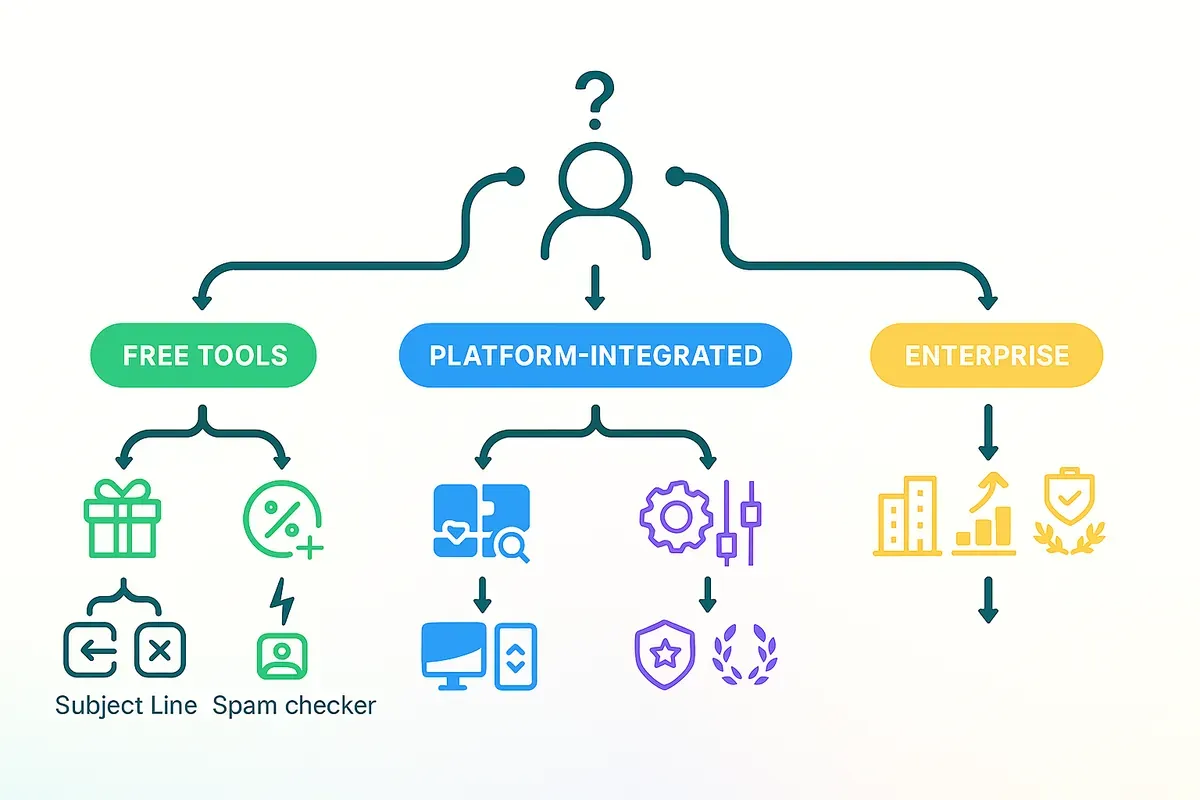
Platform-Integrated AI: Built-In Intelligence
Quick Answer: Email service providers like Mailchimp, ActiveCampaign, and Klaviyo now include native AI analytics and optimization features within their platforms, eliminating integration complexity and providing seamless workflows from insight to execution, though capabilities typically lag behind specialized standalone tools in sophistication and customization.
7. Mailchimp - Accessible AI for Small Business
Best for: Small businesses and solopreneurs new to AI-driven email marketing
Pricing: AI features available on Standard plan ($13/month) and above
Mailchimp democratizes AI email optimization through user-friendly features accessible to marketers without technical expertise. Their Content Optimizer analyzes your email drafts, predicting engagement and suggesting improvements before sending.
AI features included:
- Creative Assistant: Generates subject line and preheader suggestions based on your content
- Send Time Optimization: Analyzes subscriber behavior to recommend best send times
- Smart Recommendations: Identifies which subscribers to re-engage, which segments to prioritize
- Predicted Demographics: Fills data gaps by inferring subscriber characteristics
According to Mailchimp's internal research, users who implement their AI recommendations see average open rate improvements of 7-11% compared to baseline campaigns.
Ease of use advantage: Mailchimp's AI operates within the familiar campaign builder interface. No separate tools to learn, no export/import workflows, no third-party integrations required. Suggestions appear contextually as you build campaigns.
Real user feedback: "As a solo marketer, I don't have time for complex AI tools. Mailchimp's built-in suggestions are simple enough to implement immediately and have genuinely improved my results." – G2 review
Pricing tiers:
- Essentials: $13/month (basic AI features)
- Standard: $20/month (full AI suite including send-time optimization)
- Premium: $350/month (advanced segmentation and multivariate testing)
Honest limitations: Mailchimp's AI capabilities lag behind specialized tools in sophistication. Send-time optimization operates at the segment level, not individual subscriber level. Creative suggestions, while helpful, lack the depth of enterprise solutions like Phrasee.
Experiencing difficulty in selecting effective AI tools to enhance email campaign performance? Try Groupmail's AI Subject Line Generator—generate 10 optimized variations instantly. No signup required.
8. ActiveCampaign - Predictive Sending with CRM Integration
Best for: B2B companies with sales teams needing email-to-CRM attribution
Pricing: Starting at $49/month (Plus plan for predictive features)
ActiveCampaign combines email marketing with CRM functionality, offering AI-powered predictive sending that considers both email engagement patterns and sales pipeline activity. This integration enables more sophisticated targeting than email-only platforms provide.
Predictive sending capabilities:
- Analyzes when individual contacts typically engage
- Considers deal stage and sales activity timing
- Adjusts send times based on recent CRM interactions
- Coordinates email timing with sales rep outreach
- Learns from combined email + sales touchpoint data
AI-powered segmentation: ActiveCampaign's machine learning identifies which contacts are most likely to convert, churn, or engage, enabling proactive segmentation before obvious behavioral signals appear. According to their case studies, this predictive segmentation improves conversion rates 15-28% compared to rules-based segmentation.
Real user feedback: "The CRM integration is ActiveCampaign's killer feature. Our sales team sees which emails prospects opened, and the AI adjusts send times based on when deals typically progress. It's email marketing that actually talks to our sales process." – Capterra review
Pricing:
- Plus: $49/month (predictive sending, CRM integration)
- Professional: $149/month (advanced AI features, predictive content)
- Enterprise: Custom pricing
9. Klaviyo - E-Commerce Revenue Attribution
Best for: Online retailers needing AI that directly attributes email revenue
Pricing: Starting at $45/month
Klaviyo specializes in e-commerce analytics, using AI to predict customer lifetime value, identify optimal discount levels, and forecast which subscribers are likely to purchase. Unlike general email platforms, Klaviyo's AI focuses specifically on revenue optimization for online stores.
AI revenue features:
- Predictive Analytics: Forecasts customer lifetime value and churn probability
- Smart Send Time: Optimizes delivery based on individual purchase timing patterns
- Product Recommendations: AI-generated personalized product suggestions
- Discount Optimization: Suggests minimum discount needed to trigger purchase
- Price Drop Alerts: Automatically notifies subscribers when watched items reduce price
According to Klaviyo's benchmark data, e-commerce stores using their AI product recommendations generate 15-25% more revenue per email compared to manual product selection.
Integration depth: Klaviyo syncs directly with Shopify, WooCommerce, Magento, and BigCommerce, accessing full purchase history, browsing behavior, and inventory data. This deep integration enables AI predictions impossible with surface-level integrations.
Real user feedback: "Klaviyo's predicted LTV changed how we segment. Instead of grouping by purchase history, we now target based on future value predictions, and our retention rate increased 23% year-over-year." – G2 review
Pricing: Scales based on contact count and email volume, starting at $45/month for 1,500 contacts.
🔧 Pro Tip: When evaluating platform-integrated AI versus standalone tools, consider your technical resources. Integrated features require less setup but offer less customization. Standalone tools provide more sophisticated capabilities but demand integration maintenance.
Budget-Friendly AI Options: Optimization Without Premium Pricing
Quick Answer: Affordable AI email tools like Constant Contact and Moosend provide essential optimization features (send-time recommendations, subject line scoring, basic predictive analytics) for $9-12/month, making AI-driven improvements accessible to budget-conscious marketers, though capabilities remain more limited than premium alternatives in customization and sophistication.
10. Constant Contact - Beginner-Friendly AI
Best for: Local businesses and nonprofits prioritizing simplicity over advanced features
Pricing: Starting at $12/month
Constant Contact recently added AI capabilities to their traditionally straightforward platform, maintaining their ease-of-use focus while introducing basic optimization features.
AI features:
- Subject line suggestions
- Send-time recommendations (segment-level)
- Content suggestions based on industry
- Basic engagement predictions
Their AI operates with minimal configuration required, making it accessible to marketers uncomfortable with technical complexity. However, this simplicity comes with reduced sophistication—predictions operate at a basic level compared to specialized tools.
Best use case: Organizations prioritizing ease of use over optimization sophistication, particularly nonprofits and local businesses without dedicated marketing staff.
11. Moosend - Budget AI Automation
Best for: Startups and small teams seeking affordable automation with basic AI features
Pricing: Starting at $9/month
Moosend offers the lowest entry point for AI-powered email marketing, including automation workflows, basic predictive analytics, and send-time optimization at highly competitive pricing.
Included AI features:
- Automated A/B testing
- Send-time optimization
- Engagement predictions
- Basic product recommendations (for e-commerce)
Value proposition: Moosend delivers 60-70% of the functionality offered by tools costing 3-5x more, making it attractive for budget-conscious marketers willing to sacrifice advanced features for affordability.
Honest assessment: Moosend works well for straightforward campaigns but lacks the sophistication required for complex optimization scenarios. Customer support and documentation lag behind premium competitors.
Explore all AI email marketing tools →
How to Choose the Right AI Analytics Tool
Selecting the optimal AI analytics and optimisation tool depends on your specific needs, technical resources, and email program maturity:
Start with free tools if you're:
- New to AI-driven email marketing
- Working with limited budgets
- Testing AI's impact before platform commitment
- Using multiple email platforms and need tool-agnostic solutions
Consider platform-integrated AI if you're:
- Satisfied with your current ESP
- Seeking minimal integration complexity
- Running standard campaigns without extensive customization needs
- Prioritizing workflow simplicity over advanced capabilities
Invest in specialized tools when you're:
- Sending 50+ campaigns monthly
- Operating at enterprise scale (100K+ subscribers)
- Requiring custom brand voice training
- Managing complex B2B sales cycles with long touchpoint sequences
- Needing sophisticated individual-level optimization
Pricing vs. value calculation:
- Free tools: Maximize value with zero cost but require manual implementation
- $10-50/month: Adequate for small businesses with straightforward needs
- $50-200/month: Sweet spot for growing companies needing automation
- $500+/month: Enterprise solutions justified by high email volumes
According to research from Litmus, email marketing generates $36 for every $1 spent on average. Even modest improvements from AI optimization deliver significant ROI, making the investment decision primarily about matching sophistication to your operational complexity rather than whether AI provides value.
Key Terms:
- Send-Time Optimization: AI analysis of individual subscriber engagement patterns to determine optimal delivery timing for maximum opens and clicks
- Predictive Analytics: Machine learning models that forecast subscriber behavior (likelihood to convert, churn, engage) before obvious signals appear
- A/B Testing: Controlled experiments comparing two campaign variations to identify which performs better on specific metrics
- Natural Language Generation (NLG): AI technology that creates human-readable text (subject lines, email copy) based on performance data and brand guidelines
- Engagement Scoring: Numerical rating (typically 0-100) predicting how likely a subscriber is to interact with a campaign based on historical behavior
- Brand Voice Training: Process of teaching AI models your specific terminology, tone, and style by analyzing past communications
- List Fatigue: Declining engagement rates caused by sending too frequently, detectable through AI pattern analysis before obvious drops occur
- Smart Segmentation: AI-powered subscriber grouping based on predicted behavior rather than demographic characteristics alone
- Content Optimization: AI recommendations for improving email elements (subject lines, CTAs, images) based on performance predictions
- Deliverability Scoring: AI analysis identifying spam triggers and inbox placement risks before sending campaigns
Frequently Asked Questions
Q: Do AI email tools actually improve performance, or is it just marketing hype? A: Legitimate AI tools demonstrably improve email metrics when properly implemented. Industry research shows average open rate improvements of 15-25% and click rate increases of 10-20% within 90 days. However, results require sufficient data volume (minimum 1,000 subscribers and regular sending), proper tool configuration, and realistic expectations. AI optimizes based on patterns—if your fundamental email strategy is flawed, AI amplifies those problems rather than solving them.
Q: How much email history do AI tools need to provide accurate recommendations? A: Most AI tools require 60-90 days of historical campaign data for basic functionality and 6-12 months for sophisticated predictions. Individual send-time optimization needs subscriber-level engagement history (minimum 3 months per contact). If you're starting fresh or switching platforms, expect reduced accuracy initially as the AI builds predictive models, with performance improving as data accumulates.
Q: Can small businesses benefit from AI email optimization, or is it only valuable at enterprise scale? A: Small businesses gain significant value from AI tools, particularly free options like Groupmail's subject line generator and tester that provide immediate improvements without financial investment. However, sophisticated individual-level optimization (like Seventh Sense) requires substantial subscriber volumes to achieve statistical significance. For lists under 5,000, focus on segment-level optimization and basic AI features rather than enterprise-grade individual predictions.
Q: How do AI email tools handle data privacy and subscriber information? A: Reputable AI email tools operate under GDPR, CCPA, and industry privacy standards, using anonymized aggregate data for model training while protecting individual subscriber information. Always review a tool's privacy policy and data processing agreements. Free tools like Groupmail's analyzers process content without storing subscriber data or campaign results, making them privacy-friendly options for sensitive industries.
Q: Should I use multiple AI tools together, or does that create conflicts? A: Strategic tool combinations work well when each addresses different optimization aspects. For example, using Groupmail's free subject line tester alongside Seventh Sense's send-time optimization doesn't create conflicts because they optimize separate variables. However, running multiple A/B testing tools simultaneously can fragment data and prevent statistical significance. Choose one primary optimization platform and supplement with specialized free tools for specific needs.
Q: What's the realistic timeline to see results from AI email optimization? A: Most marketers observe initial improvements within 30-45 days of implementation, with more substantial gains appearing at 90-120 days as AI models accumulate behavioral data and refine predictions. Immediate-impact tools (subject line testers, spam checkers) provide value from day one, while predictive analytics and individual send-time optimization require longer training periods. Set expectations for gradual improvement rather than overnight transformation.
Q: Are AI-generated subject lines and email copy detectable, and do subscribers care? A: Modern AI-generated email content is indistinguishable from human-written copy when properly implemented, particularly when using brand-trained models like Phrasee. Subscribers don't care about content origin—they care about relevance and value. According to research from Litmus, 68% of marketers use some form of AI content assistance without negative subscriber response. Focus on quality and relevance rather than whether AI contributed to creation.
Q: How do I measure whether my AI email investment is working? A: Establish baseline metrics before implementation (open rates, click rates, conversion rates, revenue per email, unsubscribe rates) and compare post-implementation performance. Track both aggregate improvements and specific optimization wins (best subject line variants, optimal send times identified). Calculate ROI by comparing monthly tool cost against revenue/efficiency gains. Most effective AI implementations show positive ROI within 90-180 days when properly utilized.
Conclusion: Finding Your AI Optimization Solution
The difficulty in selecting effective AI tools to enhance email campaign performance stems not from lack of options but from choosing among many capable solutions with different strengths. The right tool depends on your specific operational context:
For immediate testing without commitment, start with free tools that provide instant value. Groupmail's AI subject line generator, tester, and spam checker work independently of your email platform, offering risk-free optimization that complements any existing setup.
For small businesses and growing teams, platform-integrated AI from Mailchimp, Moosend, or Constant Contact provides adequate sophistication within familiar interfaces, eliminating integration complexity while delivering measurable improvements.
For established programs sending 50+ campaigns monthly, specialized tools like Seventh Sense, Optimail, or ActiveCampaign justify their investment through sophisticated individual-level optimization and automated testing that compounds improvements over time.
For enterprise operations with brand consistency requirements, Phrasee-caliber solutions generate on-brand content variations at scale while maintaining voice guidelines across hundreds of monthly campaigns.
According to DMA's National Client Email Report, marketers using AI-driven optimization achieve 14% higher engagement rates and 21% better conversion performance than those relying solely on manual optimization. The question isn't whether AI improves email marketing performance—it does. The question is which tools match your current sophistication level and growth trajectory.
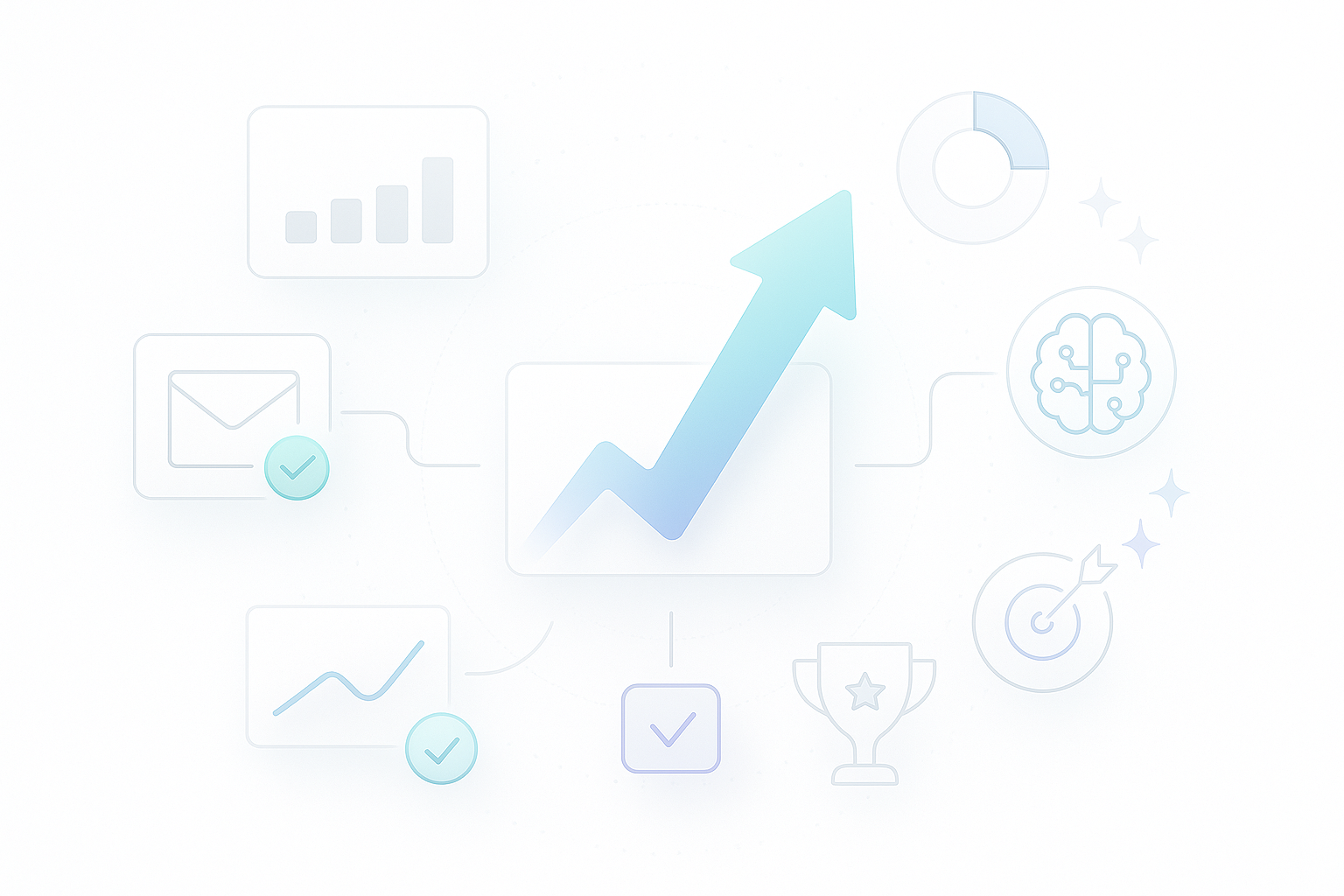
Ready to solve difficulty in selecting effective AI tools to enhance email campaign performance?
Start with our free tools—no account required:
Or explore our complete tools directory for specialized solutions.
Need a complete email marketing platform? Discover Groupmail's features—unlimited sending, drag-and-drop builder, and built-in AI optimization.
Last Updated: October 2025
Disclosure: This guide is operated by Groupmail. We provide free AI tools for anyone to use.

